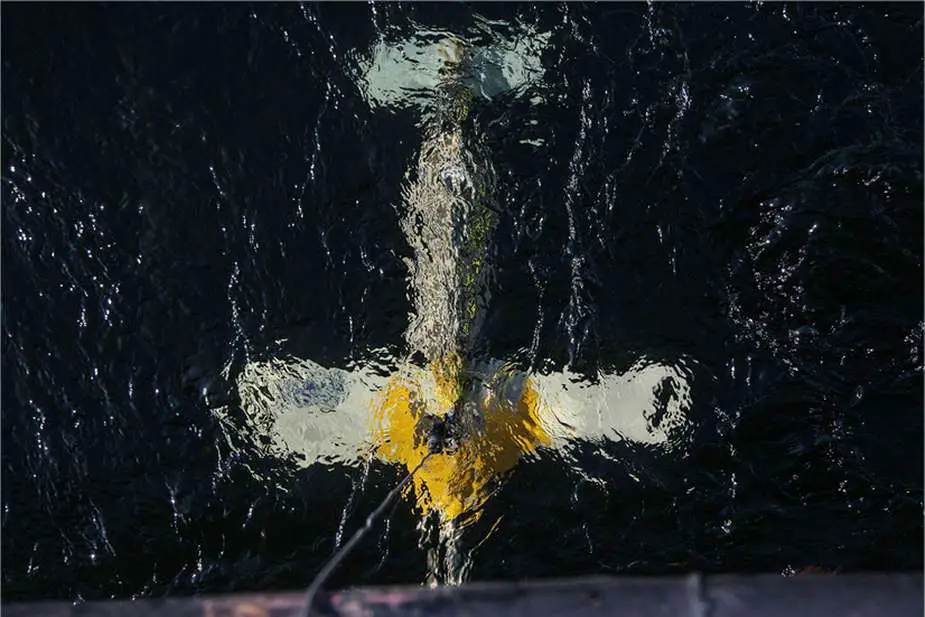On December 13, 2023, TASS reported that Russian defense industry experts are currently engaged in the development of a new attack underwater drone, as disclosed by a source within the defense-industrial complex. This project is part of Russia's broader initiative to expand its capabilities in unmanned underwater systems and naval attack drones.
Follow Navy Recognition on Google News at this link
 Illustrative image depicting the launch of a small underwater drone from a hydrographic survey vessel of the Russian Northern Fleet. (Picture source: Russian social media)
Illustrative image depicting the launch of a small underwater drone from a hydrographic survey vessel of the Russian Northern Fleet. (Picture source: Russian social media)
According to the report, the drone is equipped with four engines and is designed to operate within a 1-kilometer range, featuring a payload capacity of up to 5 kilograms. The development phase is ongoing, with testing scheduled to commence by February 2024. The drone's intended applications are diverse, including deployment in Ukraine, especially near the Dnieper River. Its primary functions involve delivering various payloads and engaging with enemy positions.
In addition to its combat roles, the drone is being developed for demining purposes, specifically for inspecting hydro-technical structures up to 30 meters deep. This functionality is intended to reduce the dependence on diver groups in areas with potentially mined bridge supports, providing an alternative solution for such scenarios. It is important to note that this drone's capacities seem to be much lower than those of the Ukrainian Marichka and Toloka underwater drones.
This advancement is indicative of a larger effort by the Russian Navy to enhance its naval drone capabilities, including unmanned surface vessels. The incorporation of more naval drones into its operations mirrors a successful strategy previously implemented by the Ukrainian Navy.
Navy Recognition reported on November 27, 2023, that Mikhail Danilenko, Managing Director of KMZ Holding, announced the imminent delivery of domestically produced naval drones to the Russian military for testing by year's end. KMZ is expected to supply ten unmanned boats to the Russian Ministry of Defense for evaluation in the Ukrainian conflict zone. These deliveries are part of ongoing discussions regarding potential mass production, contingent on the results of these initial tests. Back in September, there were indications that the military department was evaluating the acquisition of naval drones developed by KMZ, which has proposed a range of maritime drones based on the Vizir-type platform.
Additionally, as reported by Navy Recognition on December 1, 2023, Russian forces have reportedly assembled a functional prototype of the Ukrainian maritime drone SeaBaby, utilizing parts from several devices recovered at attack sites. The Russian military is believed to be reprogramming this drone for potential deployment against Ukrainian military targets. This reconstructed drone has been transferred to the 388th Special Purpose Marine Intelligence Point of the Russian Federation's Black Sea Fleet. This reverse-engineering effort will be potentially boosted by the recent claimed capture of an intact Ukrainian Magura V5 Unmanned Surface Vessel (USV).
These initiatives also include a program for training underwater drone operators within its military training center, as reported in October 2023 by the Far Eastern Federal University (FEFU) in Vladivostok, Russia. Scheduled to begin in 2024, the course is designed to utilize the university's combination of scientific knowledge and technical capabilities in the domain of underwater technology. Trainees will acquire skills in monitoring underwater engineering structures, ship hulls, and water bodies, as well as in employing unmanned crafts for defense against diver-led sabotage and protecting infrastructure from assorted threats. Practical training will involve handling the 'Marlin-350', a small civilian drone rated for depths up to 350 meters, featuring visual and echo sensors, and a manipulator.



